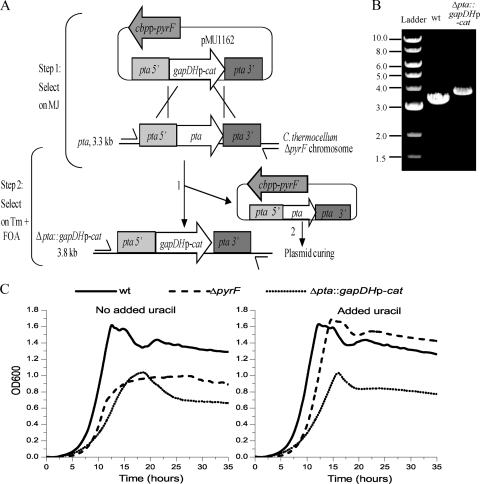FIG. 3.
Creation of a C. thermocellum Δpta::gapDHp-cat strain. (A) Relevant features of the pta deletion vector, pMU1162, are the dual selection cassette for transformation and plasmid loss (cbpp-pyrF) and the allelic replacement cassette containing gapDHp-cat between the flanking regions (pta 5′ and pta 3′). The chromosomal pta locus contains the pta gene in the context of the flanking DNA. Step 1, plating on MJ allows selection of transformants harboring pMU1162; step 2, plating on Tm plus 5-FOA selects replacement of pta with the gapDHP-cat cassette and insertion of pta into pMU1162 (numbered 1) and loss of pyrF-containing plasmid (numbered 2). Primers used for PCR are indicated by the one-sided arrows, and the sizes of the expected amplicons are shown to the left. (B) DNA image showing the results of colony PCR using primers X02051 and X02099 on the wild type (lane 2) and a putative Δpta::gapDHp-cat strain (lane 3). The numbers on the left indicate the band sizes in kb for the NEB 1-kb ladder used as a marker (lane 1). (C) Growth analysis of the WT, ΔpyrF, and Δpta::gapDHp-cat strains in rich medium with or without supplementation of uracil. The graphs indicate the OD600 of each culture over time. The μmax for the WT, ΔpyrF, and Δpta::gapDHp-cat strains were 0.55 h−1, 0.58 h−1, and 0.38 h−1, respectively, and did not change significantly upon addition of uracil.

